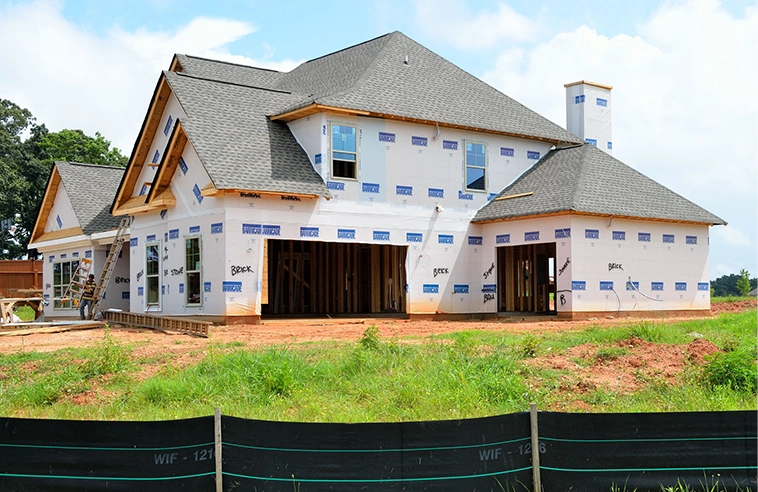Construction Safety Tech
According to OSHA [Occupational Safety and Health Administration], one out of every five workplace fatalities is a construction worker, with more than 800 construction workers dying every year and nearly 137,000 being seriously injured while on the job.
But there’s no doubt that safety has improved even over a single generation of construction workers. The fatal injury rate for the construction industry in 2019 was 9.7 per 100,000 full-time equivalent workers.[1] Between 1980 and 1994, the rate was 15.5 per 100,000 full-time equivalent workers.[2] And construction safety has certainly come a very long way since Lunch Atop a Skyscraper, the iconic photo taken in 1932!
The number one cause of construction fatalities are falls, which cause one in three construction worker deaths. Being struck by vehicles, heavy equipment, and other objects is the leading cause of construction worker injuries (and the second most common cause of death).
Alongside falls and struck-by events, trenching is another leading cause of construction worker fatalities. Trenching “kills, on average, 40 workers every year. Workers can suffer death or serious injury within minutes of being caught in a trench cave-in.”[3]
What does construction safety look like in the future? In this article, we’ll look at a few examples of technology that can help further reduce construction worker deaths and serious injuries due to falls, struck-by events, and trenching.
Construction Helmets
The hardhat is an iconic image of the construction worker, and it’s well-accepted that everybody on every construction site wears one. It has doubtless saved many lives and prevented many serious injuries. However, with a little upgrade, it could perhaps do much more.
An ordinary hardhat protects against some struck-by events and it can reduce the risk of a brain injury if a hammer falls on your head, but it’s not much help in a fall — not least because it doesn’t have a chin strap to keep it on. But what if a hardhat actually became a helmet designed to better protect the brain from falls and struck-by events? That’s what the new Ergodyne helmet is supposed to do.


Inside, there’s what’s called a Multidirectional Impact Protection System (MIPS), which is an inner frame that can move independently of the outside of the helmet.
“This can reduce the rotational energy that can cause brain shear, a condition in which the brain is abruptly rattled around inside the skull due to an impact. This kind of shock is the cause of many traumatic brain injuries, particularly those associated with angled or side impacts to the head.”[4]
It’s the same kind of technology the MIPS company uses in helmets for mountaineering, skiing, and hockey.
Here’s a video explaining the MIPS technology: MIPS Explained
Object Detection for Construction Vehicles
While helmets help to reduce the impact from struck-by events, object detection helps prevent them. When operating heavy equipment vehicles, workers have limited visibility.
“When a vehicle on a construction site has an obstructed view to the rear, OSHA’s standard requires employers to provide that vehicle with a working back-up alarm, or a spotter on site to tell the driver when it is safe to back up.”[5]
Alarms when backing up can be difficult to hear on a busy construction site, and labor shortages can make it hard to spare spotters from other tasks. Furthermore, the sides of vehicles (as well as the back) can be minimally visible to the operator and can also cause struck-by incidents.
But vehicles can be fitted with radar and camera systems to give the operators a better view of what’s around them, including personnel, objects, and site conditions (such as trenches) — helping to reduce vehicle back-over incidents and other accidents.
Geofencing for Construction Vehicles
A geofence is a virtual boundary that can be set up (and subsequently removed) around where a piece of heavy equipment is operating. They often make use of GPS [Global Positioning System]. Geofences can help prevent struck-by incidents, trench cave-ins, and electrocution. For example, if an excavator is operating beneath overhead powerlines, a geofence could be set as an upper boundary under the powerlines such that the excavator boom and stick won’t be able to cross it — preventing a collision with the powerlines.


Geofences can also be set underground, so the excavator bucket digs to that exact depth, preventing damage to deeper underground utilities. (And also eliminating the time-wasting step of re-filling a trench.) The safety advantage is that, because geofences can be set very accurately, nobody has to go into a trench to measure its depth, and a surveyor doesn’t have to check the accuracy of the trenching — thus reducing the risk of trench cave-in accidents. Geofencing can also prevent vehicles from parking too close to trenches, or dumping loads too close to them — both of which can cause trench cave-ins.
The side-to-side swing of the excavator arm can also have geofence boundaries set, reducing the possibility of, for example, swinging into traffic when excavating near a road.
Autonomous Construction Vehicles
One way to reduce the risk of injury to construction workers, is to completely remove them from the operation taking place. For example, autonomous vehicles can excavate a trench without the need for an operator inside the vehicle.


Built Robotics turns ordinary excavating vehicles into autonomous robots with an after-market installation. The company claims that in over 13,000 hours of operation, they’ve had zero robot-related safety incidents. The robot excavators use geofences and sensors to work in a specific area and to avoid obstacles, such as people and other vehicles.
Additional Resources
(NIOSH) Directory of Construction Resources
(OSHA) Prevention Videos | Construction Hazards
(OHSA) Trenching and Excavation
(NIOSH) Trenching and Excavation
5 common trenching & excavation safety hazards
(OSHA) Residential Construction Industry – Hazards and Solutions
*
If you know a builder who might find this information interesting, please forward it to them.
If you’d like to learn more about ProHome’s warranty management services, please contact Matt at (316) 706-0368 or matt@prohome.com today.
[1] Construction Worker Deaths Increase 5% in 2019, Largest Total Since 2007 [2] (CDC) Fatal Occupational Injuries — United States, 1980-1994 [3] (OSHA) Trenching – Transcript [4] Brain-Protecting Construction Safety Helmet Now Available in US [5] (OSHA) Vehicle Back-over – Transcript




